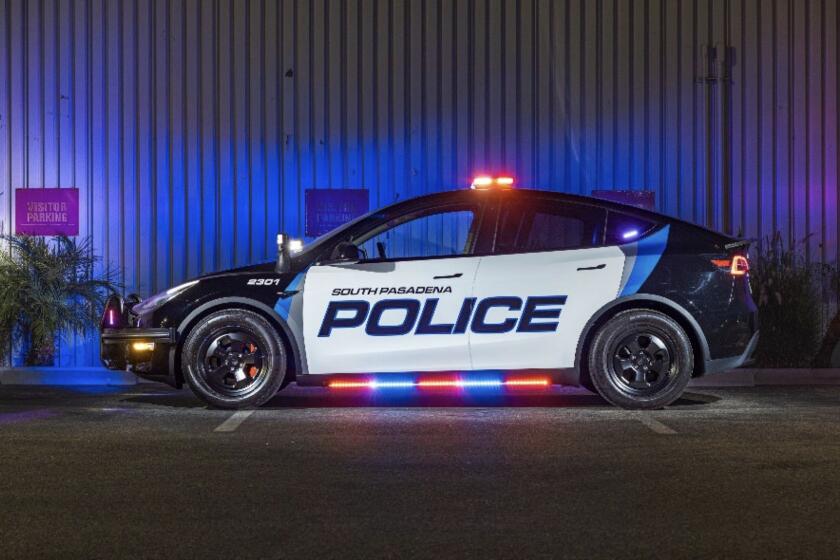Car review: Subaru refines 2015 WRX and STI
They are the bad boys of Subaru’s lineup.
Offsetting the brand’s otherwise crunchy mind-set, the WRX and WRX STI pocket rockets have worked hard to bring some tire-smoking street cred to a brand that otherwise markets its vehicles with love and puppies.
Based on the humble Impreza compact sedan, both the everyman WRX and the rally-ready STI are new for 2015. The basics stay the same: turbocharging and all-wheel-drive. But both models get an overhauled chassis, a refined cabin and fresh styling.
PHOTOS: Subaru’s 2015 WRX and STI sedans
Subaru also dumped the hatchback version, offering only a sedan. The move saved development costs, Subaru says, and two-thirds of those buying the 2013 model chose the sedan.
For 2015, the WRX model also hopes to rope in new buyers by offering an optional fuel-friendly continuously variable transmission for those unwilling to slog through traffic with a manual.
That’s not to say these models aren’t already popular. Sales for the duo grew 32% in 2013 to just under 18,000 — on a lame-duck model due for a redesign. The STI accounted for a quarter of that, and California is the most popular destination for both.
With this in mind, we put these hot-headed models to the test in various parts of the Golden State. Time in the driver’s seat revealed that Subaru has thoughtfully matured each version, yet the cars are still a total hoot to drive.
Though each uses the Impreza as a jumping-off point, the WRX and STI share very little with their softer sibling in terms of style, refinement and powertrain.
The differences start outside, with all-new sheet metal. The WRX, which starts at $27,090, offers plenty of road-shredding fun without necessarily looking like an extra from “The Fast and the Furious.” It does have the obligatory scoop built into the aluminum hood. Quad exhaust tips poke out the back, and aggressive bumpers and swollen quarter panels round out the package.
The STI, starting at $35,290, takes all this and erases any remaining subtlety with a massive trunk-mounted wing that looks as if it could tune into the Mars Rover. More that just for looks, Subaru says the wing also provides functional down force.
Although both look assertive, they left us wanting a bit more stance and shoulder to the cars, not to mention larger wheels and tires. As they sit on the road now, the cars look weaker than they really are. Hiding under the cars’ hood scoops are a pair of high-strung engines.
The STI soldiers on with the previous generation’s 2.5-liter turbocharged four-cylinder, making 305 horsepower and 290 pound-feet of torque. Its zero-to-60 mph time clocks in at 5.1, according to Subaru.
Meanwhile, the WRX has a new 2.0-liter turbocharged four-cylinder boxer engine. Pulled from duties in the Forester crossover, it makes 268 horsepower and 258 pound-feet of torque, jumps of three horsepower and 14 pound-feet over the 2.5-liter unit in the older WRX. Subaru says this version will scoot from zero to 60 mph in 5.4 seconds.
Also new on the WRX is the choice of a CVT gearbox. Dubbed the Lineartronic, this $1,200 option gives drivers three performance modes and comes standard with paddle shifters. The default setting for daily driving is Intelligent. Switch to Sport mode using the buttons on the meaty, flat-bottomed steering wheel, and the transmission mimics six manual gears; in Sport Sharp, it mimics eight.
Though enthusiasts generally greet CVTs with all the enthusiasm of an amateur root canal, this one is worth considering. The best CVTs act like traditional automatics, and this one succeeds in the imitation. The (faux) shifts are well-timed, and the paddles mimic quick, if slightly abrupt gear changes. Subaru expects about 20% of WRX buyers to choose this transmission.
Helping the CVT’s case are the foibles of the six-speed manual transmission that comes standard on the WRX. Drivers can adapt to the stiff clutch pedal, but no one will appreciate the vague but notchy shifter, especially when hustling the car at its limits (or worse, the driver’s limits).
That Subaru would sell such an able-bodied car with such a weak transmission is confounding. One has only to look to the Mazda Miata to see how smooth a manual transmission can be on an affordable, fun car. Fortunately, the only gearbox in the pricier STI is a much higher quality, crisper-shifting manual that’s worthy of its surroundings.
Transmission issues aside, the WRX is among the more engaging cars available for this kind of money. Subaru says the chassis has been retuned and stiffened, with torsional rigidity rising 40% over the Impreza.
You can feel this when you toss the WRX into tight corners; the tidy package is quick on its feet and plenty responsive. With all-wheel-drive and torque vectoring working overtime, it’s hard to get the WRX flustered.
The STI takes this and expands on it. The extra power is a tasty addition, but so too are the other elements contributing to the STI’s $8,200 price difference. This includes a hydraulic steering system (it’s electric power steering on the WRX, for better fuel economy), a more sophisticated all-wheel-drive system, beefier Brembo brakes and large alloy wheels.
Subaru also tuned the STI’s suspension to iron out the small amount of body roll evident in the lesser WRX. Around the track and on the street, the STI proves itself to be wonderfully neutral with delectable hints of rear-wheel-drive characteristics. It’s not as razor sharp as its predecessor, but feels like a more mature pocket rocket.
The chassis is solid enough, in fact, to handle a healthy dose of additional horsepower — which many buyers will no doubt add with aftermarket go-fast parts.
This refinement extends inside the two Subarus as well. The previous WRX and STI twins were little more than hot-rodded Imprezas with the same budget interior. These new examples raise the quality of the cabin beyond the Impreza’s level.
Quieter, and made from better stuff, the insides of these sedans show that the extra money spent to jump up to the 2015 WRX or STI is now spread throughout the whole car, not just the shiny mechanical bits.
They may be bad boys on the outside. But when you mix a refined interior with gains in both performance and livability, you have a rocket that fits anyone’s pocket.
david.undercoffler@latimes.com
Twitter @latimes_driven







